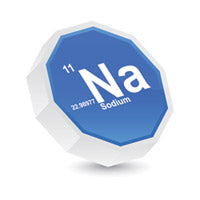Do Water Softeners Pose Health Risks?
The Chemical Process of Water Softening

Salt-based water softening works on the principle of ion exchange or ion replacement, a reversible process. (Ions are atoms or groups of atoms that can lose or gain electrons in water and therefore have an electrical charge.) Calcium (Ca2+) and magnesium (Mg2+) ions in the hard water are replaced with sodium ions (Na+) during the reversible ion-replacement reactions, as sodium ions leave the ion-exchange resin (or beads, or a chemical matrix called zeolite) and go into the water, while calcium and magnesium ions in the hard water are bound to the resin or beads. Essentially, the ions switch places during water softening: sodium from the resin matrix migrates into the water, and calcium and magnesium move from water to attach to the resin matrix. The resin or bead matrix is itself inert and does not participate in the chemical reaction, and its physical structure is not changed during water softening.
When all the sodium in the resin or beads matrix have been replaced with calcium and magnesium, the resin in the exchange chamber is "full" and cannot perform any more water-softening reactions and therefore needs to go through a process called regeneration. During regeneration, salt (sodium chloride) is added to the exchanger chamber; the high level of salt displaces the calcium and magnesium ions and replaces them with sodium. After regeneration, the resins or beads can soften more hard water.
For most healthy people, the amount of added sodium in the softened water poses no health problems. However, for people who are hypertensive (have high blood pressure) and must live on a low-sodium diet or a sodium-restricted diet, the sodium in the softened water can be hazardous to people's health.
Are There Health Problems Caused by Water Softening?
Water Softeners Do Add Sodium to Tap Water
Do Water Softeners Pose Health Risks?

The water-softener industry has tried to diminish the claims of adverse health effects of sodium addition to tap water during the water-softening process. Water Quality Association (WQA), an international nonprofit industry trade group representing residential, commercial, industrial, and small community water treatment industry, has said publicly the following:
- There are no health problems caused by ion exchange water softening. The chloride ions are not added to the water. They merely pass through the resin bed during the regeneration cycle and are discharged with the regeneration waste as calcium chloride and magnesium chloride. Sodium ions are added to the softened water in place of the calcium and magnesium that have been removed---but at an inconsequential, minute rate. Each 1 mg/L of calcium carbonate water hardness removed adds only 0.46mg/L of sodium. Water with over 1200 mg/L of total water hardness would still be classified after ion exchange softening as a "Low Sodium" beverage by the U.S. Food and Drug Administration food labeling regulations because of the trivial amount of added sodium.
Sodium in Softened Water: Is It a Health Risk?
Water softeners do add sodium to the tap water. Hence, hypertensive people—that is, people with high blood pressure—who must take a low-sodium diet, should carefully watch the water they drink. According to physicians at the Mayo Clinic, the amount of sodium added to tap water by water softeners is dependent on the "hardness" (the amount of calcium Ca2+ and magnesium Mg2+ ions) of the water. Of course, doctors say that the most effective way to reduce one's sodium intake is to cut back on salty processed foods and table salt, as these two steps can drop one's systolic blood pressure by 2 to 8 millimeters of mercury (mm Hg). But it is also important to cut the sodium in one's water as well. In fact, the water one drinks can be an important contributor of sodium in one's diet.
The physicians at the Mayo Clinic suggested that people can find the hardness of their tap water from their municipal water authority or department and then use this information to determine the amount of sodium (milligrams per liter) added to their softened water, as follows:
- Inquire at the water department about the hardness of the water in grains per gallon. "Grains" is a measure of "hardness," or calcium carbonate (CaCO3), per gallon.
- Multiply this hardness number by 8 (or 7.866 to be exact) to determine the amount of sodium added to water by a typical salt-based water-softening system. Some people try to make the calculation easy for the non-technical public by using a multiple of 7.5.
- Add this number to the sodium naturally occurring in the municipal tap water to obtain total sodium.
Do Water Softeners Pose Health Risks?

For well water, a way to estimate the amount of sodium added by salt-based water softening is to base the average of well water at 278 mg/L (although the variation can be wide, from 46 to 1,219 mg/L, and that it is estimated that 17% of households having well water have sodium levels exceeding 400 mg/L). As a general rule, the harder the water, the higher the sodium level.

Researchers publishing in the Archives of Internal Medicine said that the amount of sodium in softened water can vary. Indeed, this variability is dependent upon water hardness (Yarows et al., January 1997, "Sodium concentration of water from softeners").
According to a researcher writing in the Journal of the American Dietetic Association ("Sodium content of potable water: dietary significance," by G.C. Korch, January 1986), Americans are taking in more sodium than required for physiologic functions and that "the contribution of drinking water as a source of sodium may be overlooked" (emphasis added by the author of this Freedrinkingwater.com article). Scientists estimate that water accounts for approximately 10% of a person's daily sodium intake, and hence people should know the sodium content of their water supply. For people who are on sodium-restricted diets, they must avoid drinking softened water using traditional salt-based softening technology or just tap water (approximately 42% of the United States water supplies have excess sodium). For people on the sodium-restricted diet, they should drink purified, filtered water. For hypertensive patients, bottled water may not even be safe from sodium—it is well known that about 25 percent of all bottled water come straight from the tap but they are sold as pristine "spring water"!
We suggest that people bottle their own filtered, purified water at home using a reverse-osmosis (RO) water-purification system so that they know exactly what kind of water they're putting into their bottles. For hypertensive people or simply people concerned with their sodium intake, drinking filtered, purified water is best.
Using Potassium Instead of Sodium in Softening Water
Although the water-softening industry has claimed that the added sodium during water-softening is so insignificant that it causes no health concern, physicians and some consumer groups have advised people to use the switch to potassium-based water softening. But this is hard to put into reality yet since using potassium chloride (KCl) instead of sodium-chloride salt (NaCl) can cost three to four times more.



